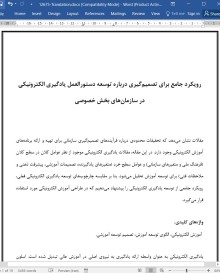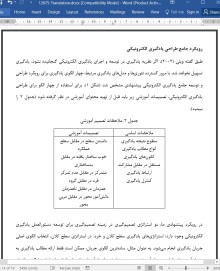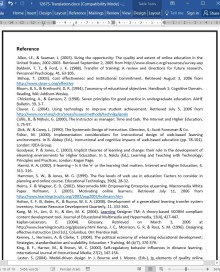
دانلود مقاله رویکرد جامع برای تصمیم گیری درباره توسعه دستورالعمل یادگیری الکترونیکی در سازمان های بخش خصوصی
نتیجهگیری و پیامدهای HRD
در تلاش برای شناسایی دستورالعملهای مربوط به توسعه یادگیری الکترونیکی، مقالات موجود یادگیری الکترونیکی را در رابطه با عوامل سطح کلان و خرد در فرهنگهای ملی و متغیرهای سازمانی مورد بررسی قرار دادیم. تصمیمات یادگیرنده و آموزنده؛ توسعه دانشکده؛ و همچنین ملاحظات فنی، چندین مدل توسعه آموزشی یادگیری الکترونیکی برای ایجاد رویکرد جامع برای توسعه یادگیری الکترونیکی مقایسه شدند. معتقدیم که رویکرد جامع پیشنهادی توسعه یادگیری الکترونیکی میتواند توسط طیف گستردهای از طراحان و مدرسان آموزش الکترونیکی مؤسسات مختلف آموزشی استفاده شود. اما، اعتقاد بر این است که رویکرد پیشنهادی فرآیند توسعه یادگیری برای سازمان بخش خصوصی معتبر است زیرا تمرکز آن به شدت بر جنبه کاربردی یادگیری و انتقال آموزشهای ارتقاء عملکرد سازمانی قرار گرفته است. یکی از بخشهای مهم مدل پیشنهادی، ادغام سطوح نتایج یادگیری در سه حوزه است که برای طراحان آموزشی، برنامههای آموزش الکترونیکی سادهتر و کارآمدتر را برای توسعه برنامههای یادگیری الکترونیکی که منعکسکننده سرعت در حال تغییر سریع نیازهای یادگیری در محیط کسب و کار هستند، آسانتر و کارآمدتر میکند.
تحقیقات آتی احتمالی برگرفته از این مطالعه میتواند شامل اثربخشی و کارایی رویکرد پیشنهادی از نظر یادگیری دانشآموز در سطوح مختلف در مؤسسات آموزشی و میزان انجام یادگیری و بهبود عملکرد در سازمانهای محل کار باشد. همچنین، مقایسه مدل پیشنهادی با سایر مدلهای طراحی آموزشی یادگیری الکترونیکی نیز مورد نیاز است.
Conclusion and Implications for HRD
In an effort to identify guidelines for e-learning development, we analyzed existing e-learning literature related to: macro and micro level factors in national cultures and organizational variables; learner and instructional decisions; faculty development; and technical considerations. Also, several instructional development models of e-learning were compared to create a comprehensive approach for e-learning development. We believe the proposed comprehensive approach of e-learning development can be used by a wide range of e-learning designers and instructors from various educational institutions. However, the proposed approach is also believed to be a valid learning development process for private sector organization since its focus is heavily placed on the aspect of learning application and transfer of training promoting organizational performance. One critical contribution of the proposed model is consolidating the levels of learning outcomes into three domains, which deemed simpler and more efficient for instructional designers to develop e-learning programs that reflect the fast changing paces of learning needs occurring in business environment.
Possible future research stemming from our study could include validating the efficiency and effectiveness of the proposed approach in terms of student learning at various settings and levels in educational institutions and the degree to which learning transfer and performance improvement is made at workplace organizations. Also, comparison of our proposed model with other types of instructional design models of e-learning is needed.
سوالات تحقیق
بررسی مقالات
تعریف و نوعشناسی یادگیری الکترونیکی
مدلهای طراحی یادگیری
روش پیشنهادی توسعه یادگیری الکترونیکی
ملاحظات اصلی برای طراحی یادگیری الکترونیکی مؤثر
ساختار محتوا و حالت تحویل
رویکرد جامع طراحی یادگیری الکترونیکی
نتیجهگیری و پیامدهای HRD
منابع
Research Questions
Literature Review
Definition and Typology of E-learning
Models of Learning Design
Proposed Approach of E-learning Development
Key Considerations for Effective E-learning Design
Content Structure and Delivery Mode
A Comprehensive E-learning Design Approach
Conclusion and Implications for HRD
Reference
- اصل مقاله انگلیسی با فرمت ورد (word) با قابلیت ویرایش
- ترجمه فارسی مقاله با فرمت ورد (word) با قابلیت ویرایش، بدون آرم سایت ای ترجمه
- ترجمه فارسی مقاله با فرمت pdf، بدون آرم سایت ای ترجمه



